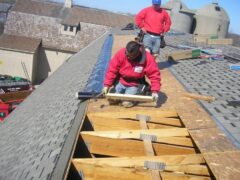
House Fires, Common Causes
An accidental fire can ignite with frightening unpredictability, spread uncontrollably in seconds, and can decimate a home within minutes. House fires endanger everyone in the home and even small fires that are put out quickly often result in thousands of dollars of damage. Having a proper insurance policy is essential to help mitigate the financial losses associated with a house fire, but it is far better to prevent the circumstances that lead to fires in the first place.
Electrical Fires
Various types of electrical faults in home wiring cause about 51,000 fires each year, accounting for nearly 500 deaths, 1,400 injuries, and about $1.3 billion in property damage. according to the EFSi (Electrical Safety Foundation international).3 Most typically, electric fires occur because of short circuits causing arcing (sparking) that ignites building materials, or from circuits that are overloaded with current, causing wires to overheat. Electrical problems account for about 10 percent of all residential fires, but this type of fire is often deadly, accounting for about 18 percent of deaths due to home fire, according to the NFPA Home Structure Fires report.1 This is likely because electrical fires often ignite in hidden locations and build into major fires before residents are aware of them. And such fires frequently may ignite while residents are sleeping.
Smoking
Smoking is hazardous to your health in many ways—including the potential for igniting fires from cigarette butts dropped on carpeting, furniture, or other flammable materials. Fires from cigarettes and smoking materials cause nearly 1,000 deaths and 3,000 injuries each year in the U.S., according to the National Fire Protection Association.1 While cigarettes and other smoking materials account for only about 5 percent of home fires, these are particularly deadly fires, responsible for about 23 percent of all fire deaths—the single most common cause. This is likely because these fires often ignite when a resident falls asleep.
Smoking in bed is especially dangerous, and should always be avoided at all cost. All it takes is a single stray ash to ignite a mattress, blanket, carpet, or piece of clothing. If you must smoke, do it outside whenever possible, or smoke over a sink while using an ashtray to help reduce your fire risk.
Christmas Trees
Christmas trees are a holiday tradition for many families, but they come with some risks. Real evergreen trees tend to dry out over time, and by the end of the holiday season, they can pose a very serious danger of flash fire. A hot light or a spark can immediately set the tree aflame, and such fires spread incredibly fast, engulfing a room in a matter of seconds. While fires caused by Christmas trees are much less common than other causes (about 160 cases annually in the U.S., according to the National Fire Protection Association), such fires can be deadly. They account for two deaths and 14 injuries each year.
Candles
The National Fire Protection Association says that between 2014 and 2018, candles caused an estimated average of just over 7,600 fires, with and average 81 deaths and 677 injuries for each of those years.4 The matches and lighters used to light candles are equally dangerous if left in a place where children can reach them. Keep matches and lighters locked in a secure place if you have kids, and never leave a candle burning in a room that is unattended.
New Year’s Day, Christmas, and New Year’s Eve are the prime time for fires caused by candles. Candles can add a wonderful touch to family dinners and holiday celebration, but always extinguish them before leaving the room. Keep candle flames at least 12 inches from any materials that might ignite. Consider other options for decorative lighting effects; there are very good battery-powered flameless luminaries that are remarkably realistic, right down to flickering in the same way that candles do.
Cooking-Related Fires
Cooking fires are among the most common types of house fires, causing around 49 percent of all residential fires.1 They are very often caused by greases that become overheated on a stove or in an oven. Grease is highly flammable when it gets hot enough (about 600 degrees Fahrenheit, on average) and when it reaches that point, it can combust spontaneously, even without direct flame contact. Once grease is ignited, it is very difficult to smother the flames.
Never leave the kitchen unattended when cooking in oil or when cooking a food that produces grease, such as bacon. Most kitchen fires start because when a homeowner leaves food cooking unsupervised on a stove or in an oven. By the time the fire is discovered, it’s usually too late. Thoroughly clean your cookware to prevent grease from building up over time.


